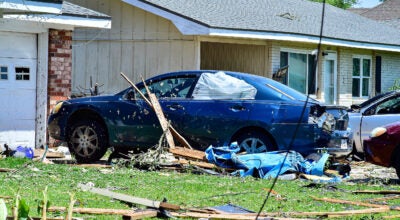Sustainable farming way of life for Hoag family
Published 8:04 pm Sunday, June 2, 2013
JENNINGS — Sustainable farming is a way of life for Warren Hoag Jr. and his family.
The family produces nearly 80 percent of what they eat on their five-acre farm on LA 26 south.
“It’s clean, nutrient dense food and its healthier,” Hoag said, noting that the family buys very little groceries. “It also tastes better and we know where it came from. I’m not always sure where the food came from in the stores, meaning that I don’t know how it was raised, what pesticides, herbicides, artificial fertilizers and food additives were used, what type of processing was used or even what country it came from.”
Hoag and his wife, Martha, a local internist and cancer survivor, changed the way they looked at food following a few health issues.
“We try to eat as much fresh, unprocessed food as we can, rich with whole grains, fruit, vegetables, along with pasture based meat, poultry and eggs,” he said.
Hoag claims his lactose intolerance and irritable bowel syndrome were resolved without use of any medicine by simply making changes in his diet. Local honey has also helped his allergies.
“You’d be amazed what you can grow on just a small portion of your yard,” he said. “Food just seems to taste better knowing that I grew it and I enjoy it so much more just knowing where it came from.”
Most of what they eat comes from the various fruit trees and vegetable gardens they grow in their backyard year round and from the animals they raise, all without the use of herbicides, pesticides, artificial fertilizers and other chemicals.
They also raise and butcher their own grass-fed cows, chickens, turkeys and ducks on the farm.
Last year the farm produced 7,000 pounds of beef, 300 dozen eggs, 300 broiler chickens and two drums of honey and more than 20 types of vegetables and fruit. Martha does the majority of the gardening while he tends to the animals.
A compost pit tucked away underneath a rabbit’s cage provides the organic materials needed to help the gardens grow and stay healthy, he said. The compost is made with dead plants from gardens and beds, manure, leaves, food scraps and woodchips found around the farm. The rabbits manure directly into the compost pit.
Solar energy, by use of solar panels, runs most of the farm using stationary and portable electric fences.
A steady rotation of the animals in the pasture helps keep the grass green and growing on the farm. The cattle are moved daily to fresh grass and contained with a portable electric fence, after they manure the area. They are not left to stand or lay in their manure.
They are never on the same piece of land for 30 days which helps break the parasite cycle (21 days). Three days later the eggmobile – a portable chicken coop on wheels – is moved behind the cattle in the pasture and the chickens fan out and scatter the cow manure (spreading the fertilizer), eat the parasite (worm) larvae hidden in the manure, thus further damaging the parasite cycle and as a result, the cattle don’t have to be wormed with chemicals.
Also, they are moved there three days after the cows because fifth day after the cows have manured the area, the fly larvae hatch into flies from the manure, so on the third day, the fly larvae is the fattest it will be and therefore the chickens have a free, natural protein source. As a result, it really dents the fly population, and the cattle don’t have to be sprayed for flies.
The chickens also manure (fertilize) and eat grass, seeds, worms. They, too are never standing in their own manure. It creates a chicken egg that is delicious, Hoag contends.
The chickens are followed by the goats, pig, and other animals, each one eating different plants and fertilizing naturally with their manure.
“We do things differently than industrial farmers,” Hoag said. “Our farm is set up to mimic nature. Each entity – cows, chickens, bees, fruit, vegetable, manure, compost, goats, rabbits and electric fences – are an important part of the whole and work synergistically with each other.”
“This is not your grandparent’s farm. We have taken the old natural ways of farming and married them to technology. Your grandparents would have been thrilled to have movable solar panels to create free electricity for fences, movable portable electric fence, a portable chicken coop on wheels with laying boxes, movable electric poultry fence that keeps chickens safe from predators, a home-made electric chicken plucker that cleans a bird in 15 seconds, portable movable shade covers to create shade for the cows, a stainless steel honey extractor, etc., yet very little infrastructure and a very low operating cost.”
This farm is really hi-tech.
“We sometimes refer to it as the farm of the future,” he said.
Most of the animals (which are heritage) do the work on the farm naturally, eating grass, seeds, bugs, worms and are seldom sick, he said.
“In nature, animals are constantly moving, not being penned up to stand and lay in their own manure,” he said. “You think about it, in the past, the buffalo roamed the plains, and the birds came in and cleaned up behind them. That’s why you see cattle egrets with cattle, eating the flies and going through the manure. By rotational and managed intensive grazing of all the animals, we are able to copy the natural cycle of the land.”
“And as a result of that, we are not depleting the soil of nutrients, and my land and grass is better than it was the year before and I didn’t buy any pesticides, herbicides, parasiticides, hormones, antibiotics, artificial fertilizer, etc,” he said. “I feel I am healing the land because I try to be a steward of God’s earth and I want to leave it in better shape for the next generation.”
By each animal taking a turn on each piece of land, weeds are kept to a minimum, Hoag said. Every animal eats a different kind of grass, weed, etc.
The parasites that affect the cattle don’t affect the goats and vice versa. The chickens clean up behind all the other animals. They act as the cleanup crew.
They also keep bees that pollinate the gardens and fruit trees.
A home-school project for their 12-year-old daughter was started with honey to help her understand the undertakings and workings of basic business. She has learned how to bottle honey, the cost of overhead, etc.
The raw honey has also helped Hoag with allergies he has been plagued with since childhood.
“I found out eating raw honey helps with pollen allergies,” he said, adding that he hasn’t had to take any allergy medicine in almost a decade. “When you pasteurize (heat) it, you kill the live enzymes. Filtering honey takes out the pollen and wax that are beneficial to your body. Raw honey retains all these natural benefits.”
Hoag is also president of the new local bee club the Bayou Beekeepers.
“We have about 20 members and would like to invite all area beekeepers from the Texas state line to the Mermentau River to come and join us,” he said. “I’m sure there are several beekeepers in the Lake Charles, Cameron, Crowley, Eunice area.”
The group meets the second Thursday at Green’s Cafe, at the corner of State and First Street in Jennings.
Warren Hoag tends to his chicken on his five-acre farm in Jennings. Hoag and his family use sustainable farming practices to produce nearly 80 percent of what they eat from their gardens and grass-fed animals. (Doris Maricle / American Press)





